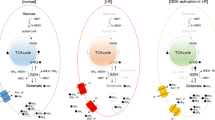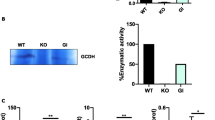Abstract
We present an update to the status of research on succinic semialdehyde dehydrogenase (SSADH) deficiency (SSADHD), a rare disorder of GABA metabolism. This is an unusual disorder featuring the accumulation of both GABA and its neuromodulatory analog, gamma-hydroxybutyric acid (GHB), and recent studies have advanced the potential clinical application of NCS-382, a putative GHB receptor antagonist. Animal studies have provided proof-of-concept that enzyme replacement therapy could represent a long-term therapeutic option. The characterization of neuronal stem cells (NSCs) derived from aldehyde dehydrogenase 5a1−/− (aldh5a1−/−) mice, the murine model of SSADHD, has highlighted NSC utility as an in vitro system in which to study therapeutics and associated toxicological properties. Gene expression analyses have revealed that transcripts encoding GABAA receptors are down-regulated and may remain largely immature in aldh5a1−/− brain, characterized by excitatory as opposed to inhibitory outputs, the latter being the expected action in the mature central nervous system. This indicates that agents altering chloride channel activity may be therapeutically relevant in SSADHD. The most recent therapeutic prospects include mTOR (mechanistic target of rapamycin) inhibitors, drugs that have received attention with the elucidation of the effects of elevated GABA on autophagy. The outlook for novel therapeutic trials in SSADHD continues to improve.






Similar content being viewed by others
References
Ainslie GR, Gibson KM, Vogel KR (2016) A pharmacokinetic evaluation and metabolite identification of the GHB receptor antagonist NCS-382 in mouse informs novel therapeutic strategies for the treatment of GHB intoxication. Pharmacol Res Perspect 4:e00265
Bay T, Eghorn LF, Klein AB, Wellendorph P (2014) GHB receptor targets in the CNS: focus on high-affinity binding sites. Biochem Pharmacol 87:220–228
Bell SM, Wendt DJ, Zhang Y et al (2017) Formulation and PEGylation optimization of the therapeutic PEGylated phenylalanine ammonia lyase for the treatment of phenylketonuria. PLoS One 12:e0173269
Buzzi A, Wu Y, Frantseva MV et al (2006) Succinic semialdehyde dehydrogenase deficiency: GABAB receptor-mediated function. Brain Res 1090:15–22
Castelli MP, Ferraro L, Mocci I et al (2003) Selective gamma-hydroxybutyric acid receptor ligands increase extracellular glutamate in the hippocampus, but fail to activate G protein and to produce the sedative/hypnotic effect of gamma-hydroxybutyric acid. J Neurochem 87:722–732
Castelli MP, Pibiri F, Carboni G, Piras AP (2004) A review of the pharmacology of NCS-382, a putative antagonist of the gamma-hydroxybutyric acid (GHB) receptor. CNS Drug Rev 10:243–260
Chellappa SL, Gaggioni G, Ly JQ et al (2016) Circadian dynamics in measures of cortical excitation and inhibition balance. Sci Rep 6:33661
Chowdhury GM, Gupta M, Gibson KM, Patel AB, Behar KL (2007) Altered cerebral glucose and acetate metabolism in succinic semialdehyde dehydrogenase-deficient mice: evidence for glial dysfunction and reducted glutamate/glutamine cycling. J Neurochem 103: 2077–2091
Cleary RT, Sun H, Huynh T et al (2013) Bumetanide enhances phenobarbital efficacy in a rat model of hypoxic neonatal seizures. PLoS One 8:e57148
Cortez MA, Wu Y, Gibson KM, Snead OC (2004) Absence seizures in succinic semialdehyde dehydrogenase deficient mice: a model of juvenile absence epilepsy. Pharmacol Biochem Behav 79:547–553
Darvish-Damavandi M, Ho HK, Kang TS (2016) Towards the development of an enzyme replacement therapy for the metabolic disorder propionic acidemia. Mol Genet Metab Rep 8:51–60
Dhamne SC, Silverman JL, Super CE et al (2017) Replicable in vivo physiological and behavioral phenotypes of the Shank3B null mutant mouse model of autism. Mol Autism 8:26
Dudek FE, Shao L-R (2004) Mossy fiber sprouting and recurrent excitation: direct electrophysiologic evidence and potential implications. Epilepsy Curr 4:184–187
Gibson KM, Sweetman L, Nyhan WL et al (1983) Succinic semialdehyde dehydrogenase deficiency: an inborn error of gamma-aminobutyric acid metabolism. Clin Chim Acta 133:33–42
Gibson KM, Aramaki S, Sweetman L et al (1990) Stable isotope dilution analysis of 4-hydroxybutyric acid: an accurate method for quantification in physiological fluids and the prenatal diagnosis of 4-hydroxybutyric aciduria. Biomed Environ Mass Spectrom 19:89–93
Gibson KM, Lee CF, Chambliss KL et al (1991) 4-Hydroxybutyric aciduria: application of a fluorometric assay to the determination of succinic semialdehyde dehydrogenase activity in extracts of cultured human lymphoblasts. Clin Chim Acta 196:219–221
Gupta M, Polinsky M, Senephansiri H et al. 2004. Seizure evolution and amino acid imbalances in murine succinate semialdehyde dehydrogenase (SSADH) deficiency. Neurobiol. Dis. 16:556–562
Gupta M, Greven R, Jansen EE et al (2002) Therapeutic intervention in mice deficient for succinate semialdehyde dehydrogenase (gamma-hydroxybutyric aciduria). J Pharmacol Exp Ther 302:180–187
Hogema BM, Gupta M, Senephansiri H et al (2001) Pharmacologic rescue of lethal seizures in mice deficient in succinate semialdehyde dehydrogenase. Nat Genet 29:212–216
Jakobs C, Bojasch M, Mönch E, Rating D, Siemes H, Hanefeld F (1981) Urinary excretion of γ-hydroxybutyric acid in a patient with neurological abnormalities. The probability of a new inborn error of metabolism. Clin Chim Acta 111:169–178
Jansen EE, Struys E, Jakobs C, Hager E, Snead OC, Gibson KM (2008) Neurotransmitter alterations in embryonic succinate semialdehyde dehydrogenase (SSADH) deficiency suggest a heightened excitatory state during development. BMC Dev Biol 8:112
Kilb W (2012) Development of the GABAergic system from birth to adolescence. Neuroscientist 18:613–630
Kok RM, Howells DW, van den Heuvel CC et al (1993) Stable isotope dilution analysis of GABA in CSF using simple solvent extraction and electron-capture negative-ion mass fragmentography. J Inherit Metab Dis 16:508–512
Lakhani R, Vogel KR, Till A et al (2014) Defects in GABA metabolism affect selective autophagy pathways and are alleviated by mTOR inhibition. EMBO Mol Med 6:551–566
Levy PD, Bellou A (2013) Acute heart failure treatment. Curr Emerg Hosp Med Rep 1(2). https://doi.org/10.1007/s40138-013-0012-8
Malaspina P, Roullet JB, Pearl PL, Ainslie GR, Vogel KR, Gibson KM (2016) Succinic semialdehyde dehydrogenase deficiency (SSADHD): pathophysiological complexity and multifactorial trait associations in a rare monogenic disorder of GABA metabolism. Neurochem Int 99:72–84
Maitre M (1997) The gamma-hydroxybutyrate signaling system in brain: organization and functional implications. Prog Neurobiol 51:337–361
Mittal R, Debs LH, Patel AP et al (2017) Neurotransmitters: the critical modulators regulating gut-brain axis. J Cell Physiol 232:2359–2372
Narayanan K, Srinivas R, Peterson MC et al (2004) Transcriptional regulation of dentin matrix protein 1 by JunB and p300 during osteoblast differentiation. J. Biol. Chem 279:44292–44302
Nylen K, Velazquez JL, Likhodii SS et al (2008) A ketogenic diet rescues the murine succinic semialdehyde dehydrogenase deficient phenotype. Exp Neurol 210:449–457
Oliveros M, Pham JT, John E, Resheidat A, Bhat R (2011) The use of bumetanide for oliguric acute renal failure in preterm infants. Pediatr Crit Care Med 12:210–214
Pearl PL, Gibson KM, Cortez MA et al (2009) Succinic semialdehyde dehydrogenase deficiency: lessons from mice and men. J Inherit Metab Dis 32:343–352
Quang LS, Shannon MW, Woolf AD, Desai MC, Maher TJ (2002) Pretreatment of CD-1 mice with 4-methylpyrazole blocks toxicity from the gamma-hydroxybutyrate precursor, 1,4-butanediol. Life Sci 71:771–778
Rahmanzadeh R, Eftekhari S, Shahbazi A et al (2017) Effect of bumetanide, a selective NKCC1 inhibitor, on hallucinations of schizophrenic patients; a double-blind randomized clinical trial. Schizophr Res 184:145–146
Schousboe A, Waagepetersen HS (2007) GABA: homeostatic and pharmacological aspects. Prog Brain Res 160:9–19
Vogel KR, Ainslie GR, Jansen EE, Salomons GS, Gibson KM (2015) Torin 1 partially corrects vigabatrin-induced mitochondrial increase in mouse. Ann Clin Transl Neurol 2:699–706
Vogel KR, Ainslie GR, Gibson KM (2016) mTOR inhibitors rescue premature lethality and attenuate dysregulation of GABAergic/glutamatergic transcription in murine succinate semialdehyde dehydrogenase deficiency (SSADHD), a disorder of GABA metabolism. J Inherit Metab Dis 39:877–886
Vogel KR, Ainslie GR, Pearl PL, Gibson KM (2017a) Aberrant mTOR signaling and disrupted autophagy: the missing link in potential vigabatrin-associated ocular toxicity? Clin Pharmacol Ther 101:458–461
Vogel KR, Ainslie GR, Roullet JB, McConnell A, Gibson KM (2017b) In vitro toxicological evaluation of NCS-382, a high-affinity antagonist of γ-hydroxybutyrate (GHB) binding. Toxicol in Vitro 40:196–202
Vogel KR, Ainslie GR, Schmidt MA, Wisor JP, Gibson KM (2017c) mTOR inhibition mitigates molecular and biochemical alterations of vigabatrin-induced visual field toxicity in mice. Pediatr Neurol 66:44–52.e1
Vogel KR, Ainslie GR, Jansen EE, Salomons GS, Gibson KM (2017d) Therapeutic relevance of mTOR inhibition in murine succinate semialdehyde dehydrogenase deficiency (SSADHD), a disorder of GABA metabolism. Biochim Biophys Acta 1863:33–42
Vogel KR, Ainslie GR, McConnell A, Roullet JB, Gibson KM (2017e) Toxicologic/transport properties of NCS-382, a γ-hydroxybutyrate (GHB) receptor ligand, in neuronal and epithelial cells: Therapeutic implications for SSADH deficiency, a GABA metabolic disorder. Toxicol In Vitro 46:203-212
Vogel KR, Ainslie GR, Jansen EE, Salomons GS, Roullet J-B, Gibson KM (2017f) In vitro modeling of experimental succinic semialdehyde dehydrogenase deficiency (SSADHD) using brain-derived neural stem cells. PLoS One 12(10):e0186919
Vogensen SB, Marek A, Bay T et al (2013) New synthesis and tritium labeling of a selective ligand for studying high-affinity γ-hydroxybutyrate (GHB) binding sites. J Med Chem 56:8201–8205
Wu Y, Buzzi A, Frantseva M, Velazquez JPL et al (2006) Status epilepticus in mice deficient for succinate semialdehyde dehydrogenase: GABAA receptor-mediated mechanisms. Ann Neurol 59:42–52
Acknowledgements
Supported in part by NIH NS 82286, NS 98856, NS 85369, and EY27476. We remain grateful for the ongoing support of the SSADH Association (www.ssadh.net).
Details of funding
Supported in part by NIH NS 82286, NS 98856, NS 85369, and EY27476.
Author information
Authors and Affiliations
Corresponding author
Ethics declarations
Conflict of interest
K.Vogel, G. Ainslie, J. Roullet, K. Gibson, D. Walters, A. McConnell, A. Rotenberg, and S. Dahmne declare that they have no conflict of interest
Additional information
Communicated by: Jaak Jaeken
Rights and permissions
About this article
Cite this article
Vogel, K.R., Ainslie, G.R., Walters, D.C. et al. Succinic semialdehyde dehydrogenase deficiency, a disorder of GABA metabolism: an update on pharmacological and enzyme-replacement therapeutic strategies. J Inherit Metab Dis 41, 699–708 (2018). https://doi.org/10.1007/s10545-018-0153-8
Received:
Revised:
Accepted:
Published:
Issue Date:
DOI: https://doi.org/10.1007/s10545-018-0153-8




